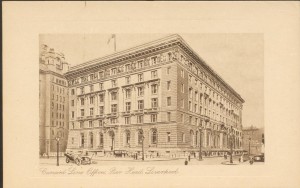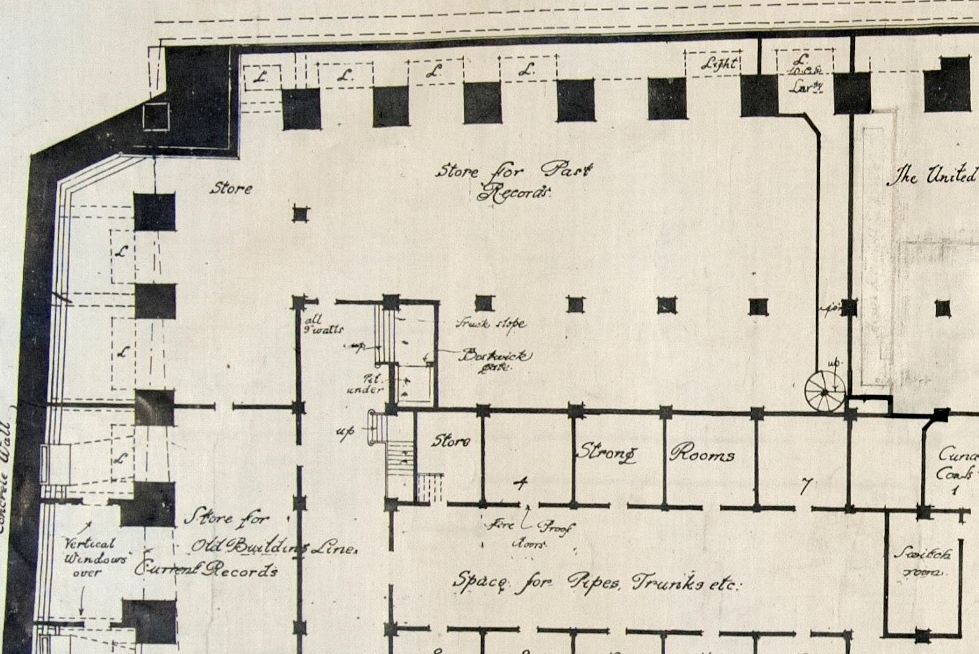This month the Cunard Building, one of Liverpool’s Three Graces, celebrates its centenary.
Cunard’s headquarters were based in Liverpool from the company’s inauguration in 1840 until 1967. The continued growth of the company saw its headquarters on Water Street become the “hub of an enormous business, concerned not just with shipping across the Atlantic to the United States and Canada, but also with routes to ports in the Mediterranean and Middle East”. Soon a purpose-built headquarters would be required and by 1914 construction of Cunard’s “shoreside palace to match the palaces of the sea”[1] would begin.
The design of the Cunard Building was the combined work of Messrs. Willink and Thicknesse of Liverpool and Messrs. Mewes and Davis of London and was based on the Farnese Palace in Rome. “Altogether, 180,000 cubic feet of Portland Stone was used on the exterior, and, 50,000 cubic feet of finest Italian marble on the interior.”[2]
Cunard’s new headquarters were completed in 1917, however there was no unveiling ceremony such as that seen with its ships. The annual reports state that Cunard’s employees relocated to the Cunard Building from their offices on Water Street in June 1916. As the country was still at war, and with many of its employees serving in the conflict, Cunard may have, as a mark of respect opened the Cunard Building without ceremony.
To mark the centenary The Passenger’s Palace -100 Years of the Cunard Building Liverpool has been published [14 June 2016]. Written by Michael Gallagher and Tony Storey this commemorative book “charts the building from its design and construction during the Great War to its role for more than 50 years as global headquarters of the company which pioneered transatlantic passenger travel.”
Business records from the Cunard Archive were used by the authors to research the development of the construction of the building and costs. Such records included minutes of the Board of Directors and Executive Committee, solicitors correspondence and accounts ledgers. The rental registers for the building were also consulted. Tenants included businesses such as Ed Bates & Sons and Lever Brothers and shipping lines such as the Booth Steamship Company and Cunard’s Anchor-Brocklebank.
Further source material within the Cunard Archive includes early plans that show the proposed layout of the different floors of the Cunard Building. As Cunard’s archive was originally stored in the basement of the Cunard Building, it is interesting to see the suggested location of ‘current’ and ‘past’ records on the basement plan.
Secondary sources within the printed book collection will be of particular interest to researchers. The commemorative brochure entitled The New Cunard Building, published after the building’s completion, contains a brief history of the company and of the City of Liverpool. The interiors and exteriors of the building are also described and illustrated with photographs taken by Messrs Bedford Lemere & Co.
John H. Chadwick, an Accountant for Cunard who worked in the Cunard Building wrote a number of poems, some of which were published in War Time Poems, a selection largely focused on Cunard’s ships and its shore and sea employees. The first poem is entitled The Cunard Building.
Information about the surviving business records within the Cunard Archive can be found on the SC&A website and in the searchable online finding aids.
[1] The story of Cunard’s 175 years : [the triumph of a great tradition]
[2] Ibid.



